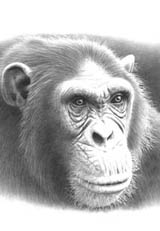Did humans and chimps once interbreed?
Bob HolmesIT GOES to the heart of who we are and where we came from. Our human ancestors were still interbreeding with their chimp cousins long after first splitting from the chimpanzee lineage, a genetic study suggests. Early humans and chimps may even have hybridised completely before diverging a second time. If so, some of the earliest fossils of proto-humans might represent an abortive first attempt to diverge from chimps, rather than being our direct ancestors.
We can observe the traces of this complex history in the human genome today, says David Reich, a population geneticist at the Broad Institute and Harvard University in Cambridge, Massachusetts. Reich and his colleagues compared the genomes of humans, chimps and gorillas using a "molecular clock" to estimate how long ago the three groups diverged. The further back two species diverged, the more differences will have accumulated between their genome sequences.
The team estimated that humans and chimps diverged no more than 6.3 million years ago, and probably less than 5.4 million years ago, although some parts of the genome showed divergence times up to 4 million years older. Even if we split from our ape relatives 6.3 million years ago, that is still later than some of the earliest fossils showing human-like traits such as altered tooth structure and bipedalism (Nature, DOI: 10.1038/nature04789). "That makes the fossil record even more interesting," says Reich. "What were those fossils?"
The answer might lie in a second striking observation. Reich's team found that the X chromosome diverged later than any of the other chromosomes. One way this can arise is if natural selection has been acting unusually strongly on genes on the X chromosome. That is significant because in every animal species studied, genes that make hybrids less fertile than their parental species tend to be found on the X chromosome or its equivalent, so hybridisation can create strong selection pressures on this chromosome.
The best explanation for these surprising findings - the relatively young and variable divergence dates between the human and chimp lineages, and the evidence for strong selection on the X chromosome - would be if the two lineages split sometime before the time of the first proto-human fossils, but later rehybridised in a "reverse speciation" event. Natural selection would favour those hybrid individuals whose X chromosomes carried fewest of the genes that lower fertility.
So far, Reich admits, this is only a plausible hypothesis, not a proven fact. For example, he calibrated his molecular clock using the divergence time between humans and macaques, which is estimated at no more than 20 million years ago. If this divergence happened earlier, that would push back the human-chimp split to an earlier date as well - perhaps far enough that there would be no need to invoke hybridisation. At the very least, though, Reich's study shows that the separation between humans and chimps was a long, drawn-out process.
HOME
Primate Info
Animal Medicine
Primate Species
Animal Rights FAQ
Chimpanzee Genome
Chimpanzee Hotlinks
Retired Chimpanzees
Self-medicating lemurs
Chimpanzee Fact Sheet
Monkey Sense of Justice
Chimpanzees: First Contact
The chimpanzee genome decoded
Facial Expressions as Guide to Speech
Young Female Chimps Outsmart Their Brothers
